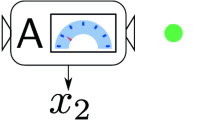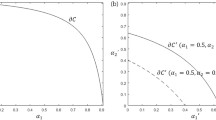Abstract
The sequential unambiguous state discrimination (SSD) of two states prepared in arbitrary prior probabilities is studied and compared with three strategies that allow classical communication. The deviation from equal probabilities contributes to the success in all the tasks considered. When one considers at least one of the parties succeeds, the protocol with probabilistic cloning is superior to others, which is not observed in the special case with equal prior probabilities. We also investigate the roles of quantum correlations in SSD and show that the procedure requires discords but rejects entanglement. The left and right discords correspond to the part of information extracted by the first observer and the part left to his successor, respectively. Their relative difference is extended by the imbalance of prior probabilities.






Similar content being viewed by others
References
Horodecki, R., Horodecki, P., Horodecki, M., Horodecki, K.: Quantum entanglement. Rev. Mod. Phys. 81, 865–942 (2009)
Bell, J.S.: On the Einstein Podolsky Rosen paradox. Physics 1, 195–200 (1964)
Ollivier, H., Zurek, W.H.: Quantum discord: a measure of the quantumness of correlations. Phys. Rev. Lett. 88, 017901 (2002)
Henderson, L., Vedral, V.: Classical, quantum and total correlations. J. Phys. A Math. Gen. 34, 6899–6905 (2001)
Lanyon, B.P., Barbieri, M., Almeida, M.P., White, A.G.: Experimental quantum computing without entanglement. Phys. Rev. Lett. 101, 200501 (2008)
Datta, A., Shaji, A., Caves, C.M.: Quantum discord and the power of one qubit. Phys. Rev. Lett. 100, 050502 (2008)
Ekert, A.K.: Quantum cryptography based on Bell’s theorem. Phys. Rev. Lett. 67, 661–663 (1991)
Pang, C.-Q., Zhang, F.-L., Xu, L.-F., Liang, M.-L., Chen, J.-L.: Sequential state discrimination and requirement of quantum dissonance. Phys. Rev. A 88, 052331 (2013)
Modi, K., Paterek, T., Son, W., Vedral, V., Williamson, M.: Unified view of quantum and classical correlations. Phys. Rev. Lett. 104, 080501 (2010)
Bellomo, B., Giorgi, G.L., Galve, F., Lo Franco, R., Compagno, G., Zambrini, R.: Dynamics of geometric and entropic quantifiers of correlations in open quantum systems. Phys. Rev. A 86, 012312 (2012)
Roa, L., Retamal, J.C., Alid-Vaccarezza, M.: Dissonance is required for assisted optimal state discrimination. Phys. Rev. Lett. 107, 080401 (2011)
Zhang, F.-L., Chen, J.-L., Kwek, L.C., Vedral, V.: Requirement of dissonance in assisted optimal state discrimination. Sci. Rep. 3, 2134 (2013)
Peres, A.: How to differentiate between non-orthogonal states. Phys. Lett. A 128, 19 (1988)
Dieks, D.: Overlap and distinguishability of quantum states. Phys. Lett. A 126, 303–306 (1988)
Bennett, C.H.: Quantum cryptography using any two nonorthogonal states. Phys. Rev. Lett. 68, 3121 (1992)
Bergou, J.A., Herzog, U., Hillery, M.: Quantum filtering and discrimination between sets of Boolean functions. Phys. Rev. Lett. 90, 257901 (2003)
Pang, S., Wu, S.: Optimum unambiguous discrimination of linearly independent pure states. Phys. Rev. A 80, 052320 (2009)
Roa, L., Retamal, J., Saavedra, C.: Quantum-state discrimination. Phys. Rev. A 66, 012103 (2002)
Chen, P.-X., Bergou, J.A., Zhu, S.-Y., Guo, G.-C.: Ancilla dimensions needed to carry out positive-operator-valued measurement. Phys. Rev. A 76, 060303(R) (2007)
Wu, X.-H., Gong, Y.-X.: Optical realization of the unambiguous discriminator for unknown quantum states. Phys. Rev. A 78, 042315 (2008)
Zhou, T.: Unambiguous discrimination between two unknown qudit states. Quantum. Inf. Process. 11, 1669–1684 (2012)
Bergou, J., Feldman, E., Hillery, M.: Extracting information from a qubit by multiple observers: toward a theory of sequential state discrimination. Phys. Rev. Lett. 111, 100501 (2013)
Nagali, E., Felicetti, S., de Assis, P.-L., Ambrosio, V.D., Filip, R., Sciarrino, F.: Testing sequential quantum measurements: how can maximal knowledge be extracted? Sci. Rep. 2, 443 (2012)
Filip, R.: Coherent versus incoherent sequential quantum measurements. Phys. Rev. A 83, 032311 (2011)
Yerokhin, V., Shehu, A., Feldman, E., Bagan, E., Bergou, J.A.: Probabilistically perfect cloning of two pure states: geometric approach. Phys. Rev. Lett. 116, 200401 (2016)
Namkung, M., Kwon, Y.: Optimal sequential state discrimination between two mixed quantum states. Phys. Rev. A 96, 022318 (2017)
Duan, L.-M., Guo, G.-C.: Probabilistic cloning and identification of linearly independent quantum states. Phys. Rev. Lett. 80, 4999–5002 (1998)
Koashi, M., Winer, A.: Monogamy of quantum entanglement and other correlations. Phys. Rev. A 69, 022309 (2004)
Coffman, V., Kundu, J., Wootters, W.K.: Distributed entanglement. Phys. Rev. A 61, 052306 (2000)
Dakić, B., Vedral, V., Brukner, Č.: Necessary and sufficient condition for nonzero quantum discord. Phys. Rev. Lett. 105, 190502 (2010)
Hillery, M., Mimih, J.: Sequential discrimination of qudits by multiple observers. J. Phys. A Math. Theor. 50, 435301 (2017)
Acknowledgements
This work is supported by NSF of China (Grant Nos.11675119, 11575125, 11105097).
Author information
Authors and Affiliations
Corresponding author
Appendices
Calculations for protocol (2) that allows classical communication
The optimization of success probability for both Bob and Charlie to succeed in identifying the state can be written as
The values of \(P_1'\) and \(P_2'\) are derived as
The case (i) in Eq. (23a) is divided into two subcases: (ia) \(\frac{s^2}{1+s^2}<P_1'\le \frac{1}{2}\) and (ib) \(0\le P_1'\le \frac{s^2}{1+s^2}\) which correspond to the results in Eq. (9a), (9b), respectively. The corresponding critical values \(P_{c1}\) in Eq. (9a) and (9b) can be acquired after solving the equation which satisfy the successive boundary condition.
For case (ii) in Eq. (23b), Bob gets optimized success probability for \(q_1^b=1\). Then, for the next observer Charlie, the conditional probability is found to be 0 (\(P_1'=0\)) according to Eq. (22) and the state \(|\psi _1\rangle \) is completely impossible to appear. Charlie can succeed in identifying the state with \(100\%\) probability because he has learned that his state is actually \(|\psi _2\rangle \). Thus, the results in Eq. (9c) are obtained.
Calculations for protocol (3) where probabilistic cloning occurs
Bob’s unitary cloning operation is given by [25]
where \(|0\rangle \) is a initialized state of the ancillas and \(|\lambda _i\rangle \), \(|\lambda _0\rangle \) are orthogonal states of the flag associated with successful cloning and failure cloning, respectively. \(\gamma _i\) is the success probability of the cloning for the state \(|\Psi _i\rangle \) and \(|\beta \rangle \) is a genetic failure state.
Thus we can get an optimized successful cloning probability as
according to Eq. (24), where \(|\lambda _1\rangle =|\lambda _2\rangle \) is required for optimal cloning [25].
If we set \(\sin {\theta _i}=\sqrt{1-\gamma _i}\) (\(i=1,2\)) for \(0\le \theta _i\le \pi /2\), the variables \(x=\cos (\theta _1+\theta _2)\), \(y=\cos (\theta _1-\theta _2)\) are further introduced. Eq. (26) is equivalent to \(2s=(1+s^2)y-(1-s^2)x\). And then we find an intermediate parameter \(\omega \) which satisfies
The range of the parameter \(\omega \) is given in Eq. (31). It’s found that
To seek the optimal value \(P_{\max }^{\mathrm{cl}}\), the following equation should be satisfied \((P_{\max }^{\mathrm{cl}})'=\frac{dP_{\max }^{\mathrm{cl}}}{d\omega }=0\). This equation is equivalent to \(P_1\gamma '_1+(1-P_1)\gamma '_2=0\), thus the following results are obtained
where
And then, the conditional probabilities \(P_i^{\mathrm{cl}}\) (\(i=1,2\)) of \(|\Psi _i\rangle \) for the following two discriminations can be obtained as \(P_i^{\mathrm{cl}}=\frac{P_i\gamma _i}{P_1\gamma _1+P_2\gamma _2}\). Hence, for the optimized successful cloning probability, \(P_i\), \(P_i^{\mathrm{cl}}\), \(P_{\max }^{\mathrm{cl}}\), \(P_{b,\max }^{\mathrm{cl}}\) and \(P_{c,\max }^{\mathrm{cl}}\) are all obtained as parametric functions of \(\omega \) with the range
where \(\omega _1\) and \(\omega _2\) correspond to the cases for \(P_1=P_2=\frac{1}{2}\) and \(P_1=0\), respectively.
At last, the optimal success probability for both Bob and Charlie to identify the state is obtained as
Thus, we can acquire the results in Eq. (11) analytically.
Optimal probability for at least one of Bob and Charlie succeeding in identifying the states
It is obvious that the optimized probability \(P_{\max }^*\) for one of their succeeding in discrimination for protocol (1) and (2) is equivalent to the results in Eq. (8). For SSD protocol, we can obtain the optimization as
Thus, this result is also equal to \(P_{\max }^{(1)}\). For protocol (3), the maximal probability is derived as
Thus, the result in Eq. (12) can be easily obtained.
Rights and permissions
About this article
Cite this article
Zhang, JH., Zhang, FL. & Liang, ML. Sequential state discrimination with quantum correlation. Quantum Inf Process 17, 260 (2018). https://doi.org/10.1007/s11128-018-2033-4
Received:
Accepted:
Published:
DOI: https://doi.org/10.1007/s11128-018-2033-4




